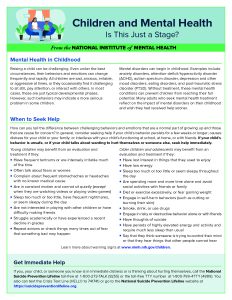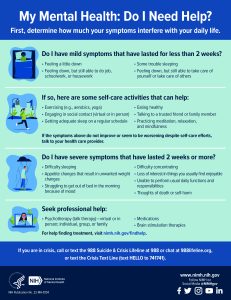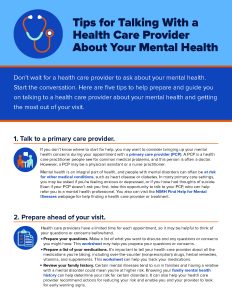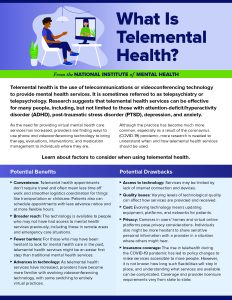Topic-Specific Resources Listed from A-Z
Psychotherapies
The following article on Anxiety Disorders is from the National Institute of Mental Health (NIMH). While this material has been expert-reviewed, it is not NIMH or MHANYS intention to provide specific medical advice. Both MHANYS and NIMH advise readers to consult with a qualified health care provider for diagnosis, treatment, and answers to personal questions.
Overview
Psychotherapy (sometimes called talk therapy) refers to a variety of treatments that aim to help a person identify and change troubling emotions, thoughts, and behaviors. Most psychotherapy takes place when a licensed mental health professional and a patient meet one-on-one or with other patients in a group setting.
You might seek out psychotherapy for many reasons, including the following:
- Dealing with severe or long-term stress from a job or family situation, the loss of a loved one, or relationship or family problems
- Having symptoms with no physical explanation, such as changes in sleep or appetite, low energy level, lack of interest or pleasure in activities you once enjoyed, persistent irritability, excessive worry, or a sense of discouragement or hopelessness that won’t go away
- A health care provider suspecting you have or diagnosing you with a mental disorder that is interfering with your life
- Supporting a family member or child who has been diagnosed with a condition affecting their mental health
First being examined by a health care provider can help ensure that there is no physical health issue that would explain symptoms. This step is important because sometimes symptoms, like a change in mood or trouble concentrating, are due to a medical condition.
Psychotherapy and other treatment options
Psychotherapy can be used as an alternative to or alongside medication and other treatment options. Choosing the right treatment plan should be based on a person’s individual needs and medical situation and occur under the guidance of a mental health professional.
Even when medication relieves symptoms, psychotherapy can help a person address specific issues. These might include self-defeating ways of thinking, irrational fears, problems interacting with other people, or difficulty coping with situations at home, school, or work.
Elements of psychotherapy
A variety of psychotherapies and interventions have shown effectiveness in treating mental health disorders. Often, the type of treatment is tailored to the specific disorder. For example, the treatment approach for someone who has obsessive-compulsive disorder is different than the approach for someone who has bipolar disorder. Therapists may use one primary approach or incorporate other elements depending on their training, the disorder being treated, and the needs of the person receiving treatment.
Elements of psychotherapy can include:
- Helping a person become aware of automatic ways of thinking that are inaccurate or harmful (for example, having a low opinion of their abilities) and then finding ways to question those thoughts, understand how the thoughts affect their emotions and behavior, and change self-defeating patterns, in an approach known as cognitive behavioral therapy (CBT)
- Identifying ways to cope with stress and developing specific problem-solving strategies
- Examining a person’s interactions with others and teaching social and communication skills
- Applying mindfulness and relaxation techniques, such as meditation and breathing exercises
- Using exposure therapy (a type of CBT) for people with anxiety disorders, in which a person spends brief periods in a supportive environment learning to tolerate the distress caused by certain items, ideas, or imagined scenes until, over time, the fear associated with those things dissipates
- Tracking emotions and behaviors to raise awareness of their impact on each other
- Using supportive counseling to help a person explore troubling issues and receive emotional support
- Creating a safety plan to help a person who has thoughts of self-harm or suicide recognize warning signs and use coping strategies, such as contacting friends, family, or emergency personnel
Note that there are many different types of psychotherapy. Therapies are often variations of an established approach, such as CBT. There is no formal approval process for psychotherapies like there is for medications by the U.S. Food and Drug Administration.
However, for many therapies, research involving large numbers of patients has provided evidence that the treatment is effective. These evidence-based therapies have been shown to reduce symptoms of depression, anxiety, and other mental disorders.
What to look for in a therapist
Therapists have different professional backgrounds and specialties. This section and the next have information that can help you find out about a therapist’s credentials and find resources for locating therapists.
The approach a therapist uses depends on the disorder being treated and the training and experience of that therapist. Therapists may combine and adapt elements of different approaches.
Once you have identified one or more possible therapists, a preliminary conversation can help you understand how treatment will proceed and decide if you feel comfortable with the therapist. Rapport and trust are essential. Discussions in therapy are deeply personal, and it’s important that you feel comfortable with the therapist and have confidence in their expertise. These preliminary conversations may happen in person, by phone, or virtually. Consider trying to get answers to the following questions:
- What are the credentials and experience of the therapist? Do they have a specialty?
- What approach will the therapist take to help you? Do they practice a particular type of therapy? What is the rationale for the therapy and its evidence base?
- Does the therapist have experience in diagnosing and treating the age group (for example, a child) and the specific condition for which treatment is being sought? If the patient is a child, how will parents or caregivers be involved in treatment?
- What are the goals of therapy? Does the therapist recommend a specific time frame or number of sessions? How will progress be assessed, and what happens if you (or the therapist) feel you aren’t starting to improve?
- Are medications an option? Is this therapist able to prescribe medications?
- Are meetings confidential? How is confidentiality assured? Are there limits to confidentiality?
Finding a therapist
Many types of professionals offer psychotherapy. Examples include psychiatrists, psychologists, social workers, counselors, and psychiatric nurses. Information on providers’ credentials is available from the National Alliance on Mental Illness.
Your health insurance provider may have a list of mental health professionals participating in your plan. When talking with a prospective therapist, ask about treatment fees, whether the therapist participates in insurance plans, and whether there is a sliding scale for fees according to income.
The following professional organizations have directories or locators on their websites for mental health care professionals:
- Academy of Cognitive and Behavioral Therapy
- American Academy of Child & Adolescent Psychiatry
- American Association for Geriatric Psychiatry
- American Association for Marriage and Family Therapy
- American Board of Clinical Social Work
- American Board of Professional Psychology
- American Psychiatric Association
- American Psychological Association
- Association for Behavioral and Cognitive Therapies
- National Association of Social Workers
- National Register of Health Service Psychologists
- Psychology Today
- Society of Clinical Psychology
National advocacy organizations provide information on finding a mental health professional, and some have practitioner locators on their websites. Examples include:
- Anxiety & Depression Association of America
- Attention Deficit Disorder Association
- Children and Adults With Attention-Deficit/Hyperactivity Disorder
- Depression and Bipolar Support Alliance
- International OCD Foundation
- Mental Health America
- National Alliance on Mental Illness
Note: MHANYS does not evaluate the professional qualifications and competencies of individual practitioners listed on these websites. These resources are provided for informational purposes only. They are not comprehensive lists, and an organization’s inclusion does not constitute an endorsement by MHANYS, NIMH, the National Institutes of Health, the U.S. Department of Health and Human Services, or the U.S. government.
University or medical school-affiliated programs may offer treatment options, including training clinics. Search the website of local university health centers for their psychiatry or psychology departments. You can also go to your state or county government website and search for the health department for information on mental health-related programs within your state.
The goal of therapy is to gain relief from symptoms, maintain or improve daily functioning, and improve quality of life. If you have been in therapy for what feels like a reasonable amount of time and are not getting better, talk to your therapist or explore other mental health professionals or approaches.
Digital health options
The telephone, internet, and mobile devices have created new opportunities to provide more readily available and accessible treatment, including in areas where mental health professionals may not be physically available. Some of these approaches involve a therapist providing help at a distance. Still, others, such as web-based programs and mobile apps, are designed to provide immediate information and feedback in the absence of a therapist.
Federal resources
- Agency for Healthcare Research and Quality : This agency offers resources and information about health care, including information on effectiveness research.
- Behavioral Health Treatments and Services : The Substance Abuse and Mental Health Services Administration (SAMHSA) provides information about treatment options and links to treatment service locators.
- National Library of Medicine’s PubMed : To read in-depth research on therapies for mental health disorders, use the PubMed database of medical literature to search for articles by topic.
Health hotlines
- 988 Suicide & Crisis Lifeline : The Lifeline provides free and confidential emotional support to people in suicidal crisis or emotional distress 24 hours a day, 7 days a week, across the United States. Call or text 988 to connect with a trained crisis counselor. Support is also available via live chat at 988lifeline.org . Para ayuda en español, llame al 988.
- Disaster Distress Helpline : People affected by any disaster or tragedy can call this helpline, sponsored by SAMHSA, to receive immediate counseling. Call or text 1-800-985-5990 to connect with a trained professional from the closest crisis counseling center within the network.
- Veterans Crisis Line : This helpline is a free, confidential resource for veterans of all ages and circumstances. Call 1-800-273-8255 and press 1, text 838255, or chat online to connect with 24/7 support.
- More NIH Health Information Lines
Handouts
 English/Español
English/Español  English / Español
English / Español
 English/Español
English/Español  English/Español
English/Español
Mental Health Association in New York State (MHANYS) has additional resources that can be accessed through its main website. These resources include links to advocacy and policy work, school-based programs, mental health wellness training programs and more.
MHANYS
mhanys.org
Advocacy and Policy
mhanys.org/advocacy-policy
Mental Health Community Partners
mhcommunitypartners.org
CarePath™
mhanys.org/carepath
SMHRT: Family Education
https://www.mentalhealthednys.org/family-education-webinar-series/
Data Source
National Institute of Mental Health: Mental Health Information Health Topics www.nimh.nih.gov/health/topics
